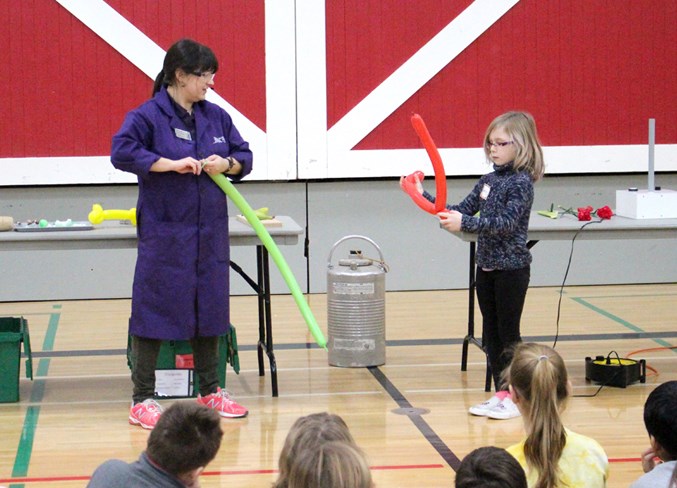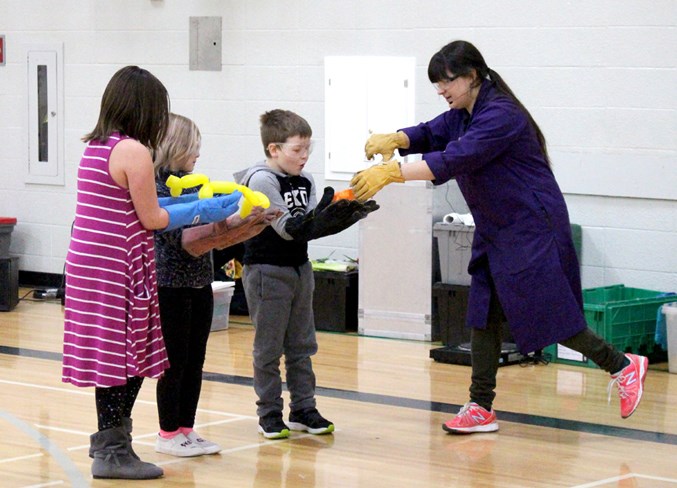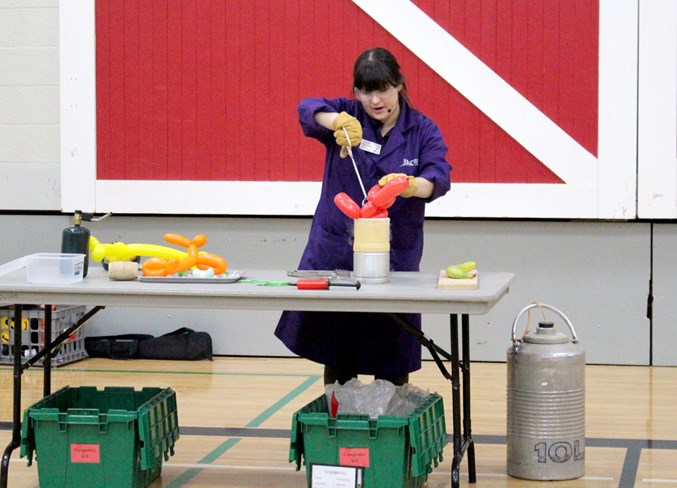It was a whole new world of science for local students.
Last week, Telus World of Science made a stop at Lakeland schools to teach youth about what happens when liquid nitrogen is introduced to items such as an animal balloon and a banana.
Duclos School students witnessed these experiments, among others, when Science in Motion, a program offered by the Telus World of Science Edmonton, visited the area on Tuesday, Dec. 4.
Electricity, fire and gas, and cryogenics were just some of the topics covered during the presentation.
Grade 2 students were in awe with seeing the various effects that liquid nitrogen had on various elements.
“We were looking at freezing the different states of manner,” explained coordinator for community outreach for the Science in Motion program, Whitney Horban. “We started off with a solid, then a liquid, and then a gas, seeing what happens when you freeze different ones, do they expand? Do they contract? Then, what changes?”
 Grade 2 student Emily Earhart (right) shows off her balloon animal making skills to Whitney Horban (left) during one of the presentations on cryogenics presentation.
Grade 2 student Emily Earhart (right) shows off her balloon animal making skills to Whitney Horban (left) during one of the presentations on cryogenics presentation.
One of the highlights during the cryogenics presentation was when Horban demonstrated the results of filling up a balloon with steam from liquid nitrogen, which Grade 2 student Kylie Trembly noted was one of her favourite parts.
“I think the balloon pop one scared me a little bit... The helium was getting too big, and just exploded somehow,” she exclaimed.
Melissa Jacob, Grade 2 teacher at Duclos, was happy to see how the day fit with their curriculum, and how her students were confident when questioned about the topic.
“We just finished our unit on liquids, so a lot of the students had the answers when she was asking for the three states. They were all excited, because they knew the answers to that. It also ties into another unit we’ll be starting a little while after Christmas, the hot and cold unit,” she explained.
The outreach program is meant to get kids interested in learning about science.
 Whitney Horban hands off a balloon animal to Duclos Grade 2 student Ryder Reid to help bring it back to life while Emily Earhart (middle) and Lily Gehrig (left) watch on.
Whitney Horban hands off a balloon animal to Duclos Grade 2 student Ryder Reid to help bring it back to life while Emily Earhart (middle) and Lily Gehrig (left) watch on.
“We always like to have an exciting, hands-on... demonstration. It’s very exciting, and they’re usually inspired about science which is what we’re coming here to do,” detailed Horban.
Along with Duclos, Science in Motion visited Dr. Bernard Brosseau, Ardmore, and Le Goff School.
It’s a unique program that travels all over Alberta, and offers opportunities some may not have, Horban said.
“It’s reaching those communities that don’t necessarily have a science centre like the Telus World of Science Edmonton in their community, we’re just bringing it out to them.”
Moving forward, Jacob plans to include aspects from the presentation into the curriculum to help students remember what they learn.
“Once we get to the hot and cold unit, I’ll be able to tie more activities , after watching the experiments, into what they’ve done. I’m looking forward to that,” Jacob said.



